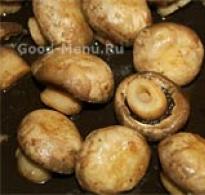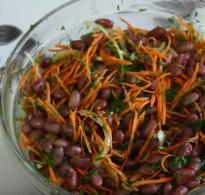Vegetables are green and non-starchy. Starch-rich foods
Starch is a complex carbohydrate known to us as a white powder similar to flour. It has no odor and distinct taste, and is produced from various plants in which it is synthesized. Of all carbohydrates consumed by humans, starch accounts for about 80%.
Once in the gastrointestinal tract, this carbohydrate is converted into glucose, which provides the body with energy. Therefore, if there is insufficient consumption of products containing it, a person feels a loss of strength, weakness and quickly gets tired.
Today on the “Popular about Health” website, we will talk to you about its benefits and harms. You will find out which products contain starch, we will compile a list of popular vegetables and fruits and discuss them further...
List of foods rich in starch
First of all, note that various grains are richest in this substance: corn, rice, wheat and oats. It is contained there, about 70-75%. There is a lot of this substance in mature peas and beans (with the exception of soybeans), semolina, wheat and rye flour.
If we talk about vegetables, the starch content is highest in root vegetables, that is, in those plants whose edible parts are located underground. But other vegetables also contain some amount of this carbohydrate.
List of fruits and vegetables rich in starch:
Potato;
- sweet potato;
- bananas;
- Jerusalem artichoke;
- horseradish and ginger;
- beet;
- carrot;
- zucchini and squash;
- tomatoes;
- radish
As for fruits, they contain almost all the minimum amount of this substance. The exception is bananas, especially green ones - they contain quite a lot of starch.
Low starch foods
The minimum content (about 1%) is noted in the following plant products: Garlic, kohlrabi, white cabbage, mushrooms, bell peppers, radishes, as well as chicory, spinach, parsnips and other garden plants - parsley, dill, lettuce, etc.
To check whether vegetables and fruits contain starch, you need to cut the plant product and drop a drop of iodine on the side of the cut. If after a minute the flesh turns blue, this carbohydrate is in the product.
Healthy and harmful starchy foods
The easiest to digest is starch from foods such as rice and semolina. The hardest thing is buckwheat, barley and pearl barley, as well as grain bread and potatoes. The hardest thing is legumes, in particular beans and peas.
Many food products contain this substance - flour, bakery and pasta products, flat cakes, sweet pastries, as well as porridges and jelly.
This carbohydrate is found in ketchups, mayonnaise, and other seasonings and sauces that we buy in the store. There is a lot of it in French fries, chips, white bread, buns and pastries.
However, it is better to avoid such products, especially for those who are watching their weight. The fact is that they have a high glycemic index.
The starch they contain is very quickly digested and absorbed, causing a sharp increase in sugar. However, its level also quickly decreases, causing a person, after a quick burst of energy, to feel a loss of strength.
In addition, frequent consumption of these and similar products has a negative impact on overall health and contributes to obesity.
But whole grain bread contains resistant starch. It takes longer and is more difficult to digest, and some of it is not absorbed at all. Consumption of such a product, on the contrary, slightly reduces sugar levels.
Also, the “correct” carbohydrate is found in beans and lentils. Here its content is very high. There is slightly less of it in whole grains of buckwheat, brown rice, and oats.
By the way, high-quality pasta, if cooked al dente and not boiled, is also healthy and does not affect body weight.
If blood glucose levels are an important indicator for you, it is better to completely exclude foods with a high glycemic index from your diet. When consuming starchy vegetables, use moderation.
But any fruits (except bananas), vegetables with moderate and low carbohydrate content, as well as leafy garden greens can and should be included in the diet more often.
A varied diet rich in vitamins will only benefit your health and reduce the risk of developing cardiovascular diseases. Be healthy!
Herbert Shelton developed the theory of separate nutrition, he also divided vegetables into two main groups - non-starchy and starchy. This separation principle is the basis for selecting different products based on their compatibility with each other.
Green non-starchy vegetables
The non-starchy group includes all juicy, crunchy, green leafy vegetables. These are turnips, asparagus, cucumbers, cabbage, broccoli, Brussels sprouts and kohlrabi, sweet peppers, rhubarb and radishes. Non-starchy vegetables also include a large group of leafy green vegetables, consisting of spinach, green leaves, beets, lettuce, bamboo shoots, onions, chicory, celery, parsley, sour sorrel, garlic, leeks, dandelion, and turnip greens. Nutritionists advise combining these vegetables with protein foods (fish, eggs and meat). Meat goes especially well with salads made from celery and other greens.
Starchy vegetables for healthy nutrition
Sauerkraut and Shelton tomatoes are classified as sour fruits. He suggests eating them with meat and fish.
Starch - advantages and disadvantages
 Starch is one of the complex carbohydrates. It is contained in fruits, vegetables, stems, leaves and roots of plants. As well as rye, wheat, various cereals, legumes and potatoes. Starch promotes the absorption of these products.
Starch is one of the complex carbohydrates. It is contained in fruits, vegetables, stems, leaves and roots of plants. As well as rye, wheat, various cereals, legumes and potatoes. Starch promotes the absorption of these products.
Shelton G. states that starchy foods are not compatible with those containing , because protein digestion requires an acidic environment, and starch digestion requires an alkaline environment. When the stomach simultaneously digests these products, fermentation and putrefaction processes begin, leading to dysfunction of the gastrointestinal tract (bloating, constipation, etc.).
People who excessively consume starchy foods provoke the formation of fatty deposits.
Green and non-starchy vegetables are the basis of separate nutrition
Unlike starchy foods, which can be combined with a limited list, non-starchy foods can be combined with almost all foods. Experts recommend that everyone eat these foods along with any other foods except dairy products and milk.
 Shelton identifies intermediate products. He gave this name to legumes (in other words, grain legumes): lentils, peas, beans, soybeans. They contain a lot of plant proteins and starch. We must admit that legumes are hard food for the stomach. Soybeans contain the least amount of starch.
Shelton identifies intermediate products. He gave this name to legumes (in other words, grain legumes): lentils, peas, beans, soybeans. They contain a lot of plant proteins and starch. We must admit that legumes are hard food for the stomach. Soybeans contain the least amount of starch.
Green leafy vegetables are also non-starchy vegetables. The group of such vegetables is very large, you can choose from it the ones that suit you, according to your own taste, and eat them with other products.
- Eating a large amount of vegetables and fruits - starchy and non-starchy.
- Consume at least 4 types of vegetables and fruits per day.
- Consuming the bulk of carbohydrates only in raw form (the norm per day is 400g).
However, consuming large quantities of raw vegetables sometimes leads to problems related to the intestines and stomach. They may be accompanied by bloating and even pain in the abdominal area. In such cases, vegetables should be eaten stewed, boiled, or steamed. Non-starchy vegetables are good for making salads for weight loss.
It must be remembered that everyone chooses for themselves which principles of nutrition are closer to them, but do not forget that, first of all, the main thing is not to harm your body. Therefore, nutritionists recommend having non-starchy and starchy vegetables in your diet. This way you can balance your diet and not harm your health.
Other interesting articles
Every day there are more and more supporters of proper nutrition. People began to pay more attention to their own health and appearance. Among the substances that contribute to the appearance of excess fat folds, starch takes its place of honor. It is present in vegetables, fruits and other foods. Many people are interested in what foods contain starch and try to protect themselves from consuming it. Is this really necessary and what are the harms and benefits of starchy foods?
What foods contain starch?
It is necessary to pay attention to the fact that all food products contain proteins, fats, sugars and starch in varying quantities. The latter is a complex carbohydrate, very necessary for the normal development and functioning of the human body. This carbohydrate can be of two types:
- Natural. Feel free to consume this type without worrying about your health. Cereals, root vegetables, potatoes, lentils and cereals contain such natural carbohydrates.
- Refined. Starch can be corn, wheat, potato, rye, rice and barley. Carbohydrates fill the body with unnecessary calories. If, for example, you dilute the refined powder with water, you will get a viscous mixture that is unpleasant to the touch. It is usually used to improve the taste, as well as to regulate the consistency of products. Therefore, starch is added to various sauces, yoghurts, dairy drinks, confectionery, even baby food.
Almost all foods that are in the human diet contain starch in one form or another. Fans of proper nutrition insist not to combine large amounts of this carbohydrate with proteins in their menu. Mostly grains and legumes contain these two substances. There is no need to give them up. Cereals are essential for the normal functioning of the human body. Knowing where the most starch and protein are located, balance your diet as much as possible.
Find out more about types of legumes, recipes.
Starchy legumes and grains
In all these cereals, the level of heavy carbohydrate exceeds 70%, so when following a diet, it is better to eat light soups without cereals. Cereals containing a large percentage of starch include:
- rice (more than 80%);
- corn;
- oats;
- wheat.

Legumes such as lentils, soybeans, beans, and peas contain high levels of carbohydrates. If you need to lose excess weight, it is best to exclude them from your diet for a while. There is no need to completely forget about them; the human body still needs the mentioned products due to the content of a number of useful substances in legumes.
This carbohydrate is found in many vegetables. Root vegetables contain the most starch, that is, those vegetables that grow underground. The group with moderate starch content includes carrots, eggplants, beets and zucchini. They go well with each other, as well as with other non-starchy vegetables. Among them, a special place in terms of the presence of starch is occupied by:
- potato;
- corn
- sweet potato;
- pumpkin;
- Jerusalem artichoke;
- radish;
- squash.
This is a long list, because this carbohydrate is found in all edible roots, including celery root, parsley and horseradish. Not obvious for such a list is cauliflower. Starchy vegetables have a specific feature: they require the addition of “light” fats. These are considered vegetable oil, cream or sour cream. The combination of carbohydrates and fats in this form will ensure optimal absorption of the dish.

Table of foods high in starch content
In order to lose excess weight or adhere to a healthy diet, you need to be more careful in choosing the healthy components of your diet. The human body simply cannot do without glycogen. Therefore, it is best to have on hand a list of foods that have high levels of this substance, and protect yourself from the leaders of this list. So, the largest amount of this carbohydrate contains:
- legumes - beans and chickpeas, the percentage of the substance here reaches 40;
- potatoes - an approximate figure of 18-20%;
- cauliflower;
- Jerusalem artichoke;
- corn;
- squash;
- pumpkin;
- sweet potato;
- radish.

What foods do not contain starch?
There are foods that do not contain starch and are necessary and beneficial for the full development of the human body. Based on them, many diets are prepared. Feel free to use them without worrying about extra pounds. This should include:
- meat of any animal;
- fish and seafood;
- eggs;
- dairy products.

The plant may also contain starch. Among plant sources, glycogen does not contain:
- cucumbers;
- chervil;
- gherkins;
- red cabbage;
- tomatoes;
- dill;
- broccoli;
- carrot.
These vegetables have other beneficial substances. Many people assume that fruit contains starch. Actually this is not true. The maximum value of this substance found in them is no more than 1%. The only exception is banana. Depending on the variety and maturity, the presence of such carbohydrate can be from 7 to 20%. It is best to buy ripe, even slightly dark bananas. Their level of this carbohydrate is lower than that of green bananas.

The list of ingredients that contain this substance is long, so it is impossible to exclude such products from your diet. There are many photo and video materials that can give a complete picture of which foods contain starch. With their help, you can create a rational and healthy diet. You can determine the carbohydrate content at home using a simple test, which is presented in the following video.
Energy, strength, good health - this is provided by products with this substance. In order to reduce its negative impact on a person’s weight, you just need to know what, at what time and in what quantity to consume. Having decided which foods contain excess starch, provide yourself with high-quality, complete, and most importantly, balanced nutrition.
We have already talked about how useful non-starchy vegetables for weight loss. It is believed that if you want to get rid of excess weight, you need to eat as little starchy foods as possible. easily digestible carbohydrates.
Quick navigation through the article:
Starch in the body
However, this is a double-edged sword, since completely eliminating starch-rich foods from your diet is also not recommended. Depriving the body of the supply of light carbohydrates affects the functioning of internal organs and may be cause of low mood and depression, general weakness of the body. To extract energy from protein dishes, the body has to make remarkable efforts, while extracting carbohydrates from starchy foods happens faster and easier. After all, starch during digestion turns into glucose, which is very quickly absorbed.
Therefore, if you include starchy vegetables in your diet, try combine them with non-starchy vegetables and fats. They are strictly forbidden to be consumed together with proteins, sugars, and acids.
Moderately starchy vegetables. List and compatibility
Many nutritionists divide all vegetables into starchy and non-starchy. Some subdivide vegetables into three groups by adding a group of moderately starchy vegetables. That is, they still contain starch, but in small quantities, so they can be included in the menu of a person losing weight. TO moderately starchy include:

- zucchini;
- zucchini;
- eggplant;
- soybeans (beans, sprouts);
- turnip;
- beet;
- carrots.
According to Herbert Shelton, the founder separate power supply, moderately starchy vegetables should include cauliflower. On the one hand, he believed that it could be classified as a non-starchy product, but on the other hand, he did not recommend eating it in large quantities, and also advised consuming it with fats. Eggplant also belongs to both moderately starchy and non-starchy vegetables, according to various experts.
Tomatoes They are neither starchy nor non-starchy vegetables. They stand apart and are not included in any of the groups. Their main components are acids: oxalic, malic, citrus. Due to its high acid content, this vegetable is classified as an acidic vegetable, and its starch content is not taken into account. Proponents of separate nutrition advise not to combine tomatoes with any other products containing starch. But tomatoes go perfectly with fats and salad vegetables, poor in starch.

Non-starchy vegetables. Full list
Nutrition experts say that non-starchy foods can be combined with any other types of food: proteins, foods containing starch, fats. Moreover, non-starchy vegetables promote their rapid breakdown and absorption, stimulate digestion, without harming the figure. Most vegetables that do not contain starch are green in color, so they are a kind of “green traffic light” for those losing weight.
Vegetables that do not contain starch are saturated with a sufficient amount of moisture, so when losing weight, a person who prefers such products feels full fairly quickly. Vegetables without starch also contain iron, which promotes better digestion of meat. That is why very often restaurants serve protein dishes in combination with “light” vegetables (cabbage, lettuce, cucumbers).
Starch, which turns into glucose when digested, is the most common form of polysaccharides in nature, so dividing vegetables into non-starchy And starchy has become part of healthy diets. Initially, the division of vegetables into non-starchy and starchy was an element of the theory of separate nutrition. Fitness calculator.
Non-starchy vegetables play a positive role for weight loss, but vice versa.
Most starch is found in roots and large grains, which store nutrients to support the growth of the plant seed. Potatoes have the highest starch content of all vegetables - up to a fifth of the volume of a potato, which is the first reason for excluding potatoes from weight loss diets.
To reduce the negative impact of starchy vegetables on the weight loss process, it is better to eat starchy vegetables with green non-starchy vegetables, fats (vegetable/animal), and it is better not to combine them with proteins, sugar and acids. We recommend eating no more than one type of starchy vegetable per meal.
Complete list of starchy vegetables.
- Corn,
- Beet,
- Swede,
- Chestnut,
- Carrot,
- Dry (ripe) beans, other than soybeans,
- Jerusalem artichoke,
- Potatoes (including sweet),
- Radish,
- Dry (ripe) peas,
- Zucchini,
- Patissons,
- Plant roots (parsley, parsnip, celery, horseradish),
- Pumpkin (round, autumn),
- Radish.
Vegetables that do not contain starch.
Everyone's favorite tomatoes, which make up a good tomato diet, are neither starchy nor non-starchy vegetables. It was found that the main nutritional characteristic of a tomato is its acidity, not the presence of starch. Due to the high content of acids (citrus, malic and oxalic) in their composition, tomatoes are classified as acidic foods, and they are not recommended to be eaten with starchy vegetables, but are allowed with leafy vegetables and fats. Online calorie calculator.
List of moderately starchy vegetables.
It should be taken into account that eggplant in various interpretations is classified as both non-starchy and moderately starchy vegetables.
Complete list of non-starchy vegetables.
- Mustard,
- Green peas,
- Turnip tops and other terrestrial green parts of edible plants,
- Beet leaves and Swiss chard,
- Eggplant,
- Broccoli,
- Brussels sprouts,
- Chicory,
- cucumbers,
- Garlic (greens, cloves),
- Spinach,
- Chinese (Beijing) cabbage,
- Cabbage (savoy, kohlrabi, white, garden, red, fodder),
- Watercress and watercress,
- Celery (greens),
- sweet pepper,
- Asparagus,
- Summer pumpkin (yellow oblong),
- Lettuce and other leaf lettuce,
- Onions (shallots, onions, chives, leeks, leeks),
- Dandelion greens,
- Okra,
- okra,
- Parsley (greens) and other table herbs,
- bamboo shoots,
- Crescent (greens),
- Sorrel.






